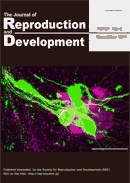All issues

Volume 43, Issue 5
June
Displaying 1-3 of 3 articles from this issue
- |<
- <
- 1
- >
- >|
Original Article
-
Tomoji MANABE, Kazufumi GOTO, Atsushi IDETA, Shinichiro TANIGUCHI, Sho ...Article type: Original Article
1997 Volume 43 Issue 5 Pages j1-j7
Published: 1997
Released on J-STAGE: October 20, 2010
JOURNAL FREE ACCESSDaily ultrasonic monitoring was conducted to examine the dynamics of bovine ovarian follicular development (large: ≥10 mm, middle: ≥5 mm and <10 mm, small: ≥2 mm and <5 mm) during the estrous cycles and early-pregnancy. Two Japanese Black cows were used in this study. One (No.2167) was observed daily for successive 90 days including two estrous cycles and subsequent early-pregnancy, and the other (No.2249) was done for consecutive 112 days over five estrous cycles. Most cycles were consisted of three waves of middle size follicles with only one large follicle (dominant follicle). The number of middle size follicles tended to decrease from around the day of the emergence of dominant follicle, and a new wave of middle size follicles emerged concomitantly with either the regression of a dominant follicle or its ovulation. The dominant follicle in the third wave was the ovulatory follicle. Until 21 days of pregnancy, the pattern of the growth and regression of middle size follicles was similar to that of the estrous cycle, but after that the wave of middle size follicles became smaller. Additionally, the maximal size of the dominant follicle in the third wave during the estrous cycles tended to be greater than those of first and second waves. During the estrous cycles, most (13 out of 14 waves) of the dominant follicles in the first and second waves appeared in the ovaries ispilateral to the corpus luteum (CL), but the ovulatory follicles in the third follicle waves always (6 out of 6 waves) appeared in the ovaries contralateral to the CL. In contrast, each dominant follicle during early-pregnancy appeared in the ovaries randomly, and had a tendency to be smaller than the maximal size of the dominant follicle in the third wave during the estrous cycles.
View full abstractDownload PDF (662K)
Technical Note
-
Naoki TAKENOUCHI, Kazunaga OHSHIMA, Kazuhiro SHIMADA, Masayoshi TAKAHA ...Article type: Technical Note
1997 Volume 43 Issue 5 Pages j9-j14
Published: 1997
Released on J-STAGE: October 20, 2010
JOURNAL FREE ACCESSA microtitre plate enzymeimmunoassay (EIA) for the determination of estradiol-17β (E2β)in bovine plasma was established. A homologous system was applied to this EIA. Antiserum against E2β-17-hemisuccinate bovine serum albumin was raised in rabbit. E2β-17-hemisuccinate peroxidase was used as a steroid-enzyme conjugate. Plasma E2β was extracted by diethyl ether and separated columun chromatography before EIA. Rabbit antiserum was used at 1:100,000 dilution for EIA. The sensitivity of the EIA was <0.25 pg/well. Out of the 12 steroids tests, high cross-reactivity was found in estrone (100%)and no cross-reactivity was found in C19 and C21 steroids. Recovery rates of E2β added to bovine plasma were 93.94-118.06% (mean=105.13%). Inter-and intra-assay coefficient of variations (CV) were 6.70-10.03% and 5.54-14.40%, respectivily. These results indicate that the EIA can be applied with sufficient sensitivity and precision for the routine analysis of bovine plasma E2β concentration.
View full abstractDownload PDF (550K) -
Masumi HIRABAYASHI, Ri-ichi TAKAHASHI, Kazumi ITO, Kunihiko KODAIRA, T ...Article type: Technical Note
1997 Volume 43 Issue 5 Pages j15-j18
Published: 1997
Released on J-STAGE: October 20, 2010
JOURNAL FREE ACCESSTransgenic rats were produced by pronuclear microinjection with 42 kinds of exogenous DNAs. The producing efficiency of transgenic rats ranged from 0.73 to 3.53% of the microinjected eggs. Promoter region, structural gene, chain length, and strand ends of the exogenous DNA was not involved in the producing efficiency of transgenic rats. The exogenous DNA can be prepared at 5 μg/ml with better efficiency than the lower and higher concentrations. Rat strain for the pronuclear eggs was a possible factor to produce transgenic rats. These results provide fundamental knowledge to produce transgenic rats effectively.
View full abstractDownload PDF (380K)
- |<
- <
- 1
- >
- >|